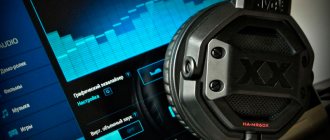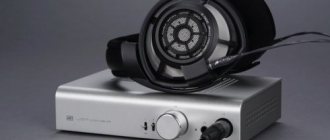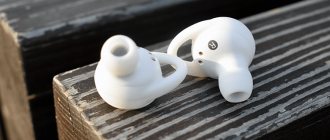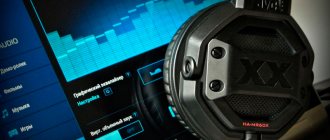Modern people often use devices such as headphones and a microphone. They facilitate communication on the Internet, allowing you not only to hear, but also to respond to another user. Connecting all the necessary devices to your computer will not be difficult, the main thing is not to forget to make all the necessary settings. However, despite the friendly interface, sometimes strange problems arise. How to remove the noise and hiss on your headphones that occurs when connected to a computer? It will be useful for everyone to know about this information.
Equipment check
The first thing you should do if extraneous noise appears in your headphones is to check the serviceability of the headset and its compatibility with the transmitting device. Carefully inspect and clean the connectors and plugs from dirt - even small specks of dust can cause interference due to loose contacts.
Mechanical damage to headphones
A “hissing” headset should be inspected for visible damage: chips, cracks or cable kinks. After making sure that the headphones are outwardly in good working order, they should be connected to another smartphone or laptop - if the extraneous noise disappears, then the problem is not in the headset, but in the transmitting device.
If the interference does not disappear, the headphones themselves are most likely faulty. You can find the location of physical damage to the cable (if it looks intact on the outside) by carefully bending and unbending it in different areas - when the broken contact is mechanically connected, the sound will become clear again. You can fix a broken cord yourself, but it’s easier to buy a new one - they are not that expensive.
Most often, the wire is damaged at the connection points with the headset or plug , as well as in areas that may be subject to mechanical stress (for example, chair wheels).
Audio jack problems
Most PCs have two audio outputs, one on the back and one on the front of the case. In this case, the rear connector is located directly on the sound card, and the front connector is connected via a cable. If noise or interference occurs when connecting to the front output, the problem is a damaged jack or cable. In this case, the easiest way would be to use only the sound card connector to listen to music.
On a note. The sound from your headphones may become quiet or poor quality due to earwax or dust contaminating the speaker grilles.
Noise in wireless earphone due to Bluetooth mismatch
Wireless headsets connect to any transmitting device using the Bluetooth Classic (BR/EDR) protocol, which was specially designed for communication with headphones, speakers, and other audio output systems. Therefore, the Bluetooth version cannot influence the appearance of noise in wireless headphones.
Interference in the speakers may occur when the transmitted information is recoded. If one of the devices does not support the codecs necessary for clear sound (LDAC, AAC, LL, aptX,), then noise in the wireless headphone will appear due to the fact that the gadget uses the standard SBC codec, which is not capable of providing high-quality sound.
Computer sound card problem
The rarest situation, which needs to be checked only if all other methods have been tried. An incorrectly functioning sound card is not capable of fully processing the audio signal, so the quality of sound reproduction through a headset or computer speakers may deteriorate significantly. You can check the serviceability of the board if you disconnect it from the system and install another one.
Before replacing the audio card, it is recommended to disconnect all devices from the computer, except those without which the PC cannot work and reboot it. If the problem still does not go away, then the problem is most likely in the sound card.
The operation of computer components depends on the condition and relevance of the drivers , therefore, before disconnecting and changing the audio card, you need to make sure that everything is in order with its software.
Causes of cod
Problems with sound through the headset can occur both in games and when performing other tasks on the computer, such as surfing the web or watching videos. The type of operation where the audio track is played rarely causes the problem.
The following factors most often affect sound quality:
- damage to the headset cable;
- dust getting into the external speaker;
- using additional effects of Windows 10;
- exclusive PC mode;
- outdated sound card drivers.
The identified causes are divided into hardware and software. In the first case, the culprits are the headphones themselves, and in the second, the computer settings. If software problems are easily solved by changing a few parameters, then hardware difficulties make you think about replacing the equipment.
The most common causes of background noise in headphones
Simple ways to remove noise from headphones that you should definitely try before moving on to more complex actions. In 90% of cases, the problem lies precisely in them, and it does not matter what model of headphones is used: expensive Airpods or Sony Pro, or budget Airdots from Xiaomi
Power Saving Mode
The energy-saving mode on the transmitting device provokes the appearance of extraneous noise. This problem is most common on laptops, but can also occur on PCs or smartphones. When you turn on battery saving mode, the system redirects all resources to important devices, and the sound card may not have enough power to operate the built-in amplifier or other equipment.
You can eliminate this cause by selecting the “High Performance” scheme in the computer’s power settings, or by disabling the battery saving mode on iPhone or Android smartphones.
If changing the power supply type does not improve the sound, it is worth returning to a balanced circuit (or energy-saving on phones) so as not to waste battery power.
Low battery on headset
When the battery of Bluetooth headphones runs low, the device does not have enough energy to fully receive and reproduce the signal, so the sound from the speakers may be played quietly or with background noise. To check whether a low battery affects the purity of playback, you should fully charge the headset and reconnect it to your PC or smartphone.
If all else fails and your Airpods are still cracking
The above actions helped some, while others did not notice any improvement. In the latter case, there is only one thing left - to apply for a service, which for the price of Airpods simply must be carried out at the highest level, as it should be in the case of smart gadgets.
Yes, in this case, the headset can be repaired (that is, the problem may return) or only one of the two devices can be replaced (difficulties with synchronization). But this is a chance to get working devices without losing money.
We really hope that you won’t have to deal with the problem of defective sound in AirPods Pro (there are also users who bought them in October 2019 and still can’t get enough of them). And if you have to, we sincerely wish that the problem is solved simply and quickly.
Share the material with your friends to help them 100% appreciate the quality of premium equipment. And be sure to tell us how your Airpods of any generation work and what you like/dislike about them.
Why does noise occur in headphones?
Hissing, wheezing and other unpleasant sounds in working headphones can occur due to the activity of other gadgets or even household appliances.
Extraneous noise in headphones due to other devices
- Switched-on speakers that are close to the headset often generate noise from the headphones . You can get rid of their influence by simply turning off the power; there is no need to disconnect the speakers from the sound card.
- Devices using Bluetooth. Noise in wireless headphones often occurs when connecting other Bluetooth gadgets. To fix the problem, disconnect all third-party devices and reconnect the headset.
- USB devices can also interfere with the system; you can eliminate third-party influence by freeing all USB ports on your PC or laptop.
- Computer elements. Cracking, white noise or beeping in the speakers may appear due to the influence of DVD drives, drives, or video cards. To identify the “culprit”, you need to turn off the devices one by one, each time checking to see if the sound has changed.
- Household appliances can also emit electromagnetic waves. You can check its influence in the same way as in the case of small gadgets - by turning off the devices one by one.
- Cellular and TV towers. If a hum in the background of music playback or a telephone conversation through a headset appears while driving down the street, then the cause of the extraneous noise is a cell tower or other device that creates interference . In this case, it is enough to simply move away from the source of the extra signal.
Sometimes, after turning off the phoning device, you need to reboot the wireless headset for the sound quality to return to normal.
Cracking sound in speakers due to mouse movement
Loud background noise in headphones sometimes occurs when scrolling the mouse wheel, in which case it is impossible to work normally while listening to music or playing a computer game. To fix the problem, you can try:
- Switch the manipulator to another connector.
- Change the mouse connection type from USB to PS/2 or vice versa (in order not to buy a new gadget, you can use an adapter).
- Replace the mouse with a new one (preferably wireless).
Sometimes interference in the headphones can occur due to the devices of neighbors, for example, if they turn on a hammer drill or other phonic device close to the wall.
Noise in headphones from active microphone
Headphone noise from the sound card's microphone jack may be heard even if nothing is connected to the jack. This happens if the port is activated in the Windows settings - its empty slot may cause noise. You can remove microphone noise by turning it off:
- Expand the settings menu (via the corresponding icon in the Start menu).
- Open the “Sound” section.
- Click on the “Sound Control Panel” line in the right menu.
- Go to the “Recording” tab.
- Select the microphone and click on the “Properties” button.
- On the “Levels” tab, click on the icon with the speaker drawn so that the red deactivation icon appears.
The device must be turned off; simply lowering the volume level will not solve the problem.
USB devices
Strange sounds may appear after connecting additional devices to the USB connector. So, the source of problems can be the mouse or even the keyboard. In this case, you will hear a clicking sound every time you press a key. This happens due to the following reasons.
- Increased load when transmitting information. The situation can be corrected by switching the plug to an adjacent port. You can find a suitable splitter, repair old connection connectors, or switch to wireless devices.
- Broken USB connector. As mentioned above, you can call a technician to repair worn parts. In real life, users exploit ports until only one is left in working order, after which a splitter is purchased and all the necessary equipment is connected to it. In addition, modern devices are designed for high loads, manufacturers take into account all the details, and the ports are created as reliable as possible.
USB splitter
Noise when connecting headphones due to incorrect settings
To understand why noise appears when you connect headphones, you should carefully check all operating system parameters that relate to sound playback.
Low volume on the transmitting device
Interference in headphones or speakers appears as the volume level increases, and the cheaper the device, the lower this threshold is for it. If professional speakers (for example, Apple AirPods Pro or Beats) begin to wheeze and hum only at maximum volume, then cheap speakers or headsets lose sound quality already when approaching 50%. You can reduce the load on the speakers if you set the volume in the transmitting device to maximum so that the headphones play at the lowest possible level of their own volume.
Third-party audio control software may also cause interference.
Device conflict in: Windows 10
Extraneous noise in speakers or headphones often occurs due to the activity of other audio devices; turning off unnecessary elements is easy:
- Go to the Windows 10 settings menu (by clicking on the gear icon in the lower left corner of the Start menu).
- Open the “System” section.
- In the left panel, select “Sound”.
- In the menu that opens, click on the line “Sound Control Panel”.
- Right-click on the icons to disable all unnecessary devices.
Important! The Troubleshoot button in the Sound menu starts a Windows service that automatically checks the system.
Additional sound effects
Advanced sound settings in Windows 10 are designed to improve the quality of playback or enhance the sound, but sometimes they may not work correctly, causing unnecessary noise or wheezing. To disable the option, you need to:
- Open the “Sounds” menu (the fastest way to do this is by right-clicking on the speaker icon in the notification panel).
- Go to the "Playback" tab.
- Select the desired sound device and click on the “Properties” button.
- Go to the “Advanced” section.
- Check the “Disable all effects” checkbox.
Sometimes noise may occur due to incorrect playback format. Most sound cards support 16-bit, 44100 Hz; if this parameter does not suit you, you can try the standard settings or refer to the device documentation.
Method 1: Physically checking the headphones
The first priority is to check the wire, plug and headphones themselves. Make sure that the cable, headphones and their speakers are not physically damaged. After this, inspect the connectors on the wire and clean them of any debris or dust, if present. Do the same with the port where you connect the equipment. Even slight contamination can lead to noise and interference due to improper connection of contacts.
If, after a visual check and cleaning of the connectors, the noise still does not go away, proceed to the next test method, which will avoid the need to edit system parameters.
How to remove noise from headphones on a computer caused by driver problems
To make sure that your audio card is working correctly, you should check the status of the system software and update it if necessary. How to remove noise in headphones on a computer that appears due to missing or incorrect drivers:
- Right-click on the “Start” button and select “Device Manager” from the menu that opens.
- In the directory tree, find and expand the “Audio inputs and outputs” category; if there is a red or yellow icon next to the name of the sound card, then the device is not working correctly.
- To update the drivers, you need to right-click on the name of the audio card and select the appropriate context menu item.
- If the system does not find the required software, you can download it yourself and indicate the path to the file to the update service by selecting manual driver installation mode.
Sound settings in Windows 10
When the problem is not with the drivers, and reinstalling them did not help get rid of wheezing, you should use the sound settings. Setting up is not difficult; to do this, you need to follow these steps:
- Login to the Control Panel via the Start button. It is located in the lower left corner of the monitor; you can also use the keyboard button with the corresponding icon.
- Go to the "Hardware and Sound" section.
- Open “Sound” and find the device you need that is connected to your computer.
- Right-click on it and go to headset properties.
- Adjust the settings to get the desired result.
When carrying out these manipulations, keep the equipment turned on to determine the effectiveness of the adjustment and the change in sound quality.











